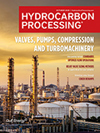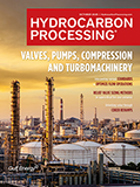Products
Automatic gauging addresses tank farm challenges
Tank farms are often found on the premises of large refineries and petrochemical plants, or nearby.
Modified shed decks tackle crude tower fouling problems
Many tray designs have been complicated by the hunt for the “perfect distillation tray” design.
Executive Viewpoint: Now and into the future: Challenges and solutions for the global processing industries
<i>Hydrocarbon Processing</i> sat down with senior-level executives of Merichem Company, Cyndie Fredrick (CF) and Kathy Young (KY), Senior Vice Presidents and General Managers of Merichem’s two business units, to discuss the state of the downstream industry, where it is heading in the future and how their company is helping operators meet their sustainability goals.
Editorial Comment: A shift in capital? Petrochemical projects take lead in active project market share
In mid-June, I joined Thad Pittman, Senior Research Analyst, <i>Hydrocarbon Processing’s</i> Construction Boxscore Database, to provide <i>Hydrocarbon Processing</i> subscribers with a global analysis on the downstream processing industry’s capital projects landscape.
Projects as programs: A vision for long-term project success
Process industries across the globe grapple with producing dozens or even hundreds of different products.
Address measurement uncertainty in pipelines and storage
How would you measure the volume of a can of soup? The height should work, but what about diameter? Or, you can possibly just trust what the manufacturer has told you on the label.
Construction
Anadarko Petroleum Corp. has reached a full agreement with CCS JV, a JV between Chiyoda, McDermott and Saipem, for the development of its Mozambique Area 1 LNG terminal.
Business Trends: US RPET and sustainability goals—a reality check
Three primary drivers exist for recycling polyethylene terephalate (PET) bottles.
Editorial Comment: Embracing uncertainty for a better tomorrow
The downstream processing industry is changing.
Our waste is our resource—An initiative to turn all plastics bio-based
The vision is fully fossil-free plastics production.

- BGN announces strategic MoU with XCF Global to produce and supply SAF 11/17
- KazMunayGas and Uzbekneftegaz partner to build 50,000-tpy linear alkylbenzene plant 11/17
- Chevron joins race to explore potential purchase of Lukoil assets, including refineries 11/17
- Abra Group and Sumitomo sign MoU to advance affordable SAF in Brazil 11/17
- Sonatrach signs contract for unit with Sinopec subsidiary to boost gasoline production capacity 11/17
- Verso Energy awards FEED contract to Rely for the DEZiR eSAF project 11/17




